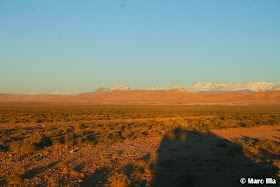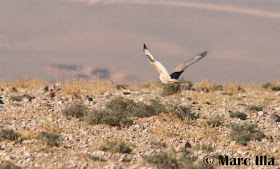Togeher with Lídia, we travelled around Morocco for 10 days during this February. We spend some days ringing in Yasmina lake, you'll find it explained in this other post.
Back to the rest of the travel, I'll resume it in some main moments or areas.
February is probably not the best month for birding, but still, we had some very nice views of some of the target species. And in terms of migration, it can be quite nice too, specially with some nice presaharan species (like Moussier's Redstart Phoenicurus moussieri) and some transaharan like Iberian Chiffchaffs (Phylloscopus ibericus).
Fôret des Cedres (Ifrane - Azrou)
We passed half day in the magic Cedar forest, but the unexpected amount of snow in the whole area forced us to stay in the tarmac road almost all the time.

We first stopped in Ifrane, where we quickly found some African Blue Tits (Cyanistes teneriffae ultramarinus) around. In this area you can spot some species that are harder to see in other places, such as Coal Tit (Periparus ater), Eurasian Nuthatch (Sitta europaea) and Mistle Thrush (Turdus viscivorus), to say some examples.



Also, in terms of interesting subspecies, you can see some Crossbills (Loxia curviristra polygina)...

Anyway, the star species in the area are Levaillant's Woodpecker (Picus vaillanti), that we heard and saw close to Azrou, and the very curious Barbary Macaques (Macaca sylvana).


.JPG)
Merzouga area (except Yasmina lake)
Between netrounds and some middays we got some time to explore other desert places around Yasmina.
There're some nice oueds to explore, giving always some interesting species.
There're some nice oueds to explore, giving always some interesting species.
 |
| Moussier's Redstart (Phoenicurus moussieri) |
 |
| Hoopoe Lark (Alaemon alaudipes) |
 |
| Southern Grey Shrike (Lanius meridionalis elegans) |
 |
| Desert Wheatear (Oenanthe deserti) |
.JPG) |
| Brown-necked Raven (Corvus ruficollis) |
 |
| Spotted Sandgrouses (Pterocles senegallus) |
And even this unexpected rarity for Morocco:
An overview of the typical habitat...

 |
| Isabelline Wheatear (Oenanthe isabellina) |

 |
| With, as usual, some migrants resting on the trees, like this Hoopoe (Upupa epops). |
Tagdilt track (Boumalne Dades)
This is one of the most popular places for birding in Morocco. The area is a very big plain area, with many many kilometres, covered with small vegetation.
 |
| In the back, you can see the High Atlas, with a lot of snow. |
The place is good specially for Alaudidae and Sandgrouses. There are some pools that are specially good, but they were completely dry.
February is maybe a bit early for Crem-coloured Cursor (Cursorius cursor), but it should be easy to find some Larks around.
Temminck's Lark (Eremophila bilopha) was especially common. We saw about 40 birds, and some of them very close...

.JPG)
We found some Short-toed Larks (Alaudala rufescens) too, but no clues of Thick-billed Larks (Ramphocorys clotbey)...
Red-rumped Wheatear (Oenanthe moesta) was initially hard to see too, but we finally managed to see two nice males. Some Black-bellied Sandgrouses (Pterocles orientalis) too, and this Long-legged Buzzard (Buteo rufinus) carrying something for the nest (we guessed).

Back to Boumalne Dades village, it was really easy to see, very well, some House Buntings (Emberiza sahari).

If you visit the area, it's worth a visit to Dades Gorges. Apart from the chances to see African Rock Martin (Ptyonoprogne fuligula) and breeding Tristram's Warbler (Sylvia deserticola), the landscape is unique.

Atlantic coast (Agadir-Tamri)
The road between Agadir and Tamri that follows the coastline is really nice. There are some viewpoints where you can stop and take a look to the long beaches, usually full of Gulls.


The commonest species was Lesser Black-backed Gulls (Larus fuscus), followed in abundance by Audouin's Gull (Larus audouinii).


But soon, we forgot about the Osprey because of a big flock of big black birds...

And we got closer...

.JPG)


 |
| Bald Ibisses (Geronticus eremita) |
 |
| We got very nice veiws... |

Sidi Boughaba (Kenitra)
Sidi Boughaba is a big lake between the beach and Kenitra village. From the road that surround it you can see already some nice species such as Red-knobbed Coot (Fulica cristata), but you can go inside the reserve and you'll get proper views.
.JPG)
.JPG)
There was quite a lot of White-headed Ducks (Oxyura leucocephala), more than 100 birds for sure.


The trees in the southern part had a big Great Cormorant's (Phalacrocorax carbo) roost. We checked them for ring, and we finally spotted a Swiss bird!
.JPG)
The place is quite good for birding actually. There were some Iberian Chiffchaffs (Phylloscopus ibericus) around, Barn Swallows (Hirundo rustica) and Sand Martins (Riparia riparia) were very common too. In the lagoon, nice numbers of Shoveler (Anas clypeata), some Common Teals (Anas crecca), Red-crested Pochards (Netta rufina), Common Pochards (Aythya ferina), Ferrugineous Ducks (Aythya nyroca), a nice male Tufted Duck (Aythya fuligula)...
.JPG)

.JPG)
We'll try to make a proper trip report of the trip. For the moment, we'll still keep many nice memories for us, but I'll end this post with our last sunset there, the 'We'll be back' moment of the trip.


No comments:
Post a Comment